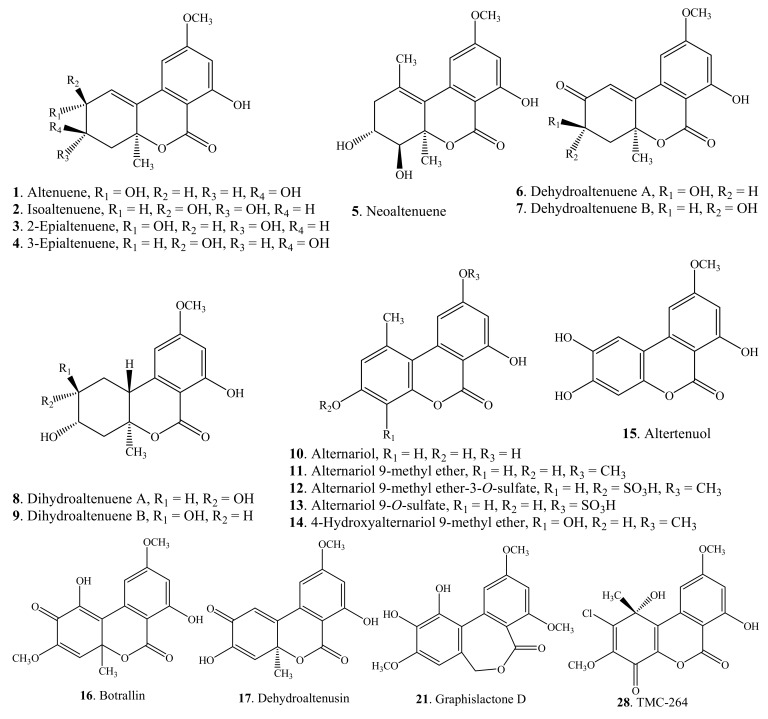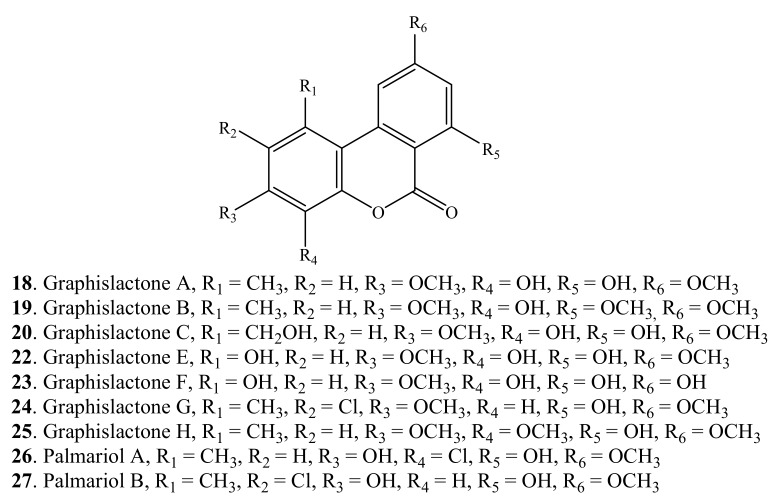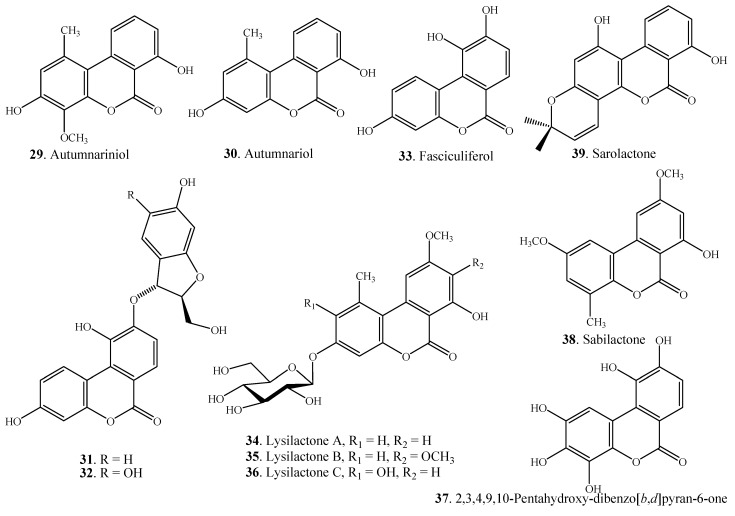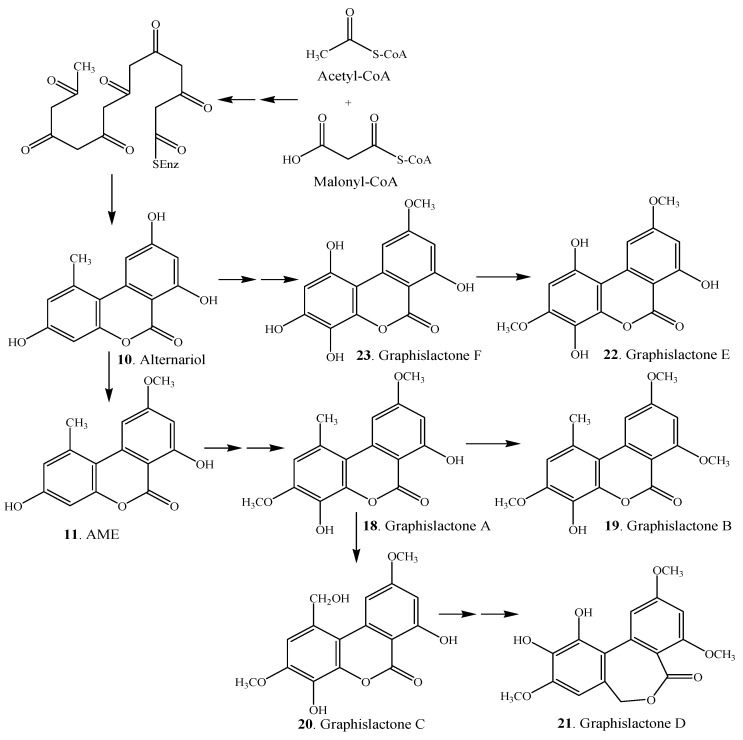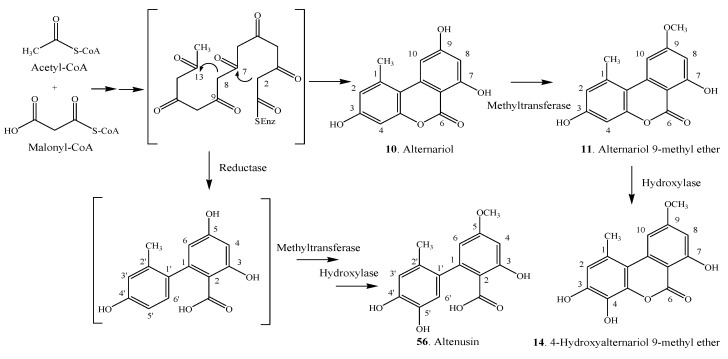Abstract
Natural dibenzo-α-pyrones are an important group of metabolites derived from fungi, mycobionts, plants and animal feces. They exhibit a variety of biological activities such as toxicity on human and animals, phytotoxicity as well as cytotoxic, antioxidant, antiallergic, antimicrobial, antinematodal, and acetylcholinesterase inhibitory properties. Dibenzo-α-pyrones are biosynthesized via the polyketide pathway in microorganisms or metabolized from plant-derived ellagitannins and ellagic acid by intestinal bacteria. At least 53 dibenzo-α-pyrones have been reported in the past few decades. This mini-review aims to briefly summarize the occurrence, biosynthesis, biotransformation, as well as their biological activities and functions. Some considerations related to synthesis, production and applications of dibenzo-α-pyrones are also discussed.
Keywords: dibenzo-α-pyrones; dibenzo-α-pyranones; 6H-benzo[c]chromen-6-ones; 6H-dibenzo[b,d]pyran-6-ones; biological activities
1. Introduction
Dibenzo-α-pyrones (also named dibenzo-α-pyranones, 6H-benzo[c]chromen-6-ones, and 6H-dibenzo[b,d]pyran-6-ones) are an important group of heptaketide coumarin derivatives that have a fused tricyclic nucleus (Figure 1). They are usually isolated from fungi [1], mycobionts [2,3], plants [4,5], and animal feces containing the transformed products of plant-derived ellagitannins and ellagic acid by intestinal bacteria [6,7]. Many of them possess a wide spectrum of biological activities, spanning from toxicity on human and animals [8], cytotoxic activity [9], phytoxicity [10], antioxidant [6], antiallergic [11], antimicrobial [12], to acetylcholinesterase inhibitory activities [13]. In addition, dibenzo-α-pyrones are key intermediates in the synthesis of cannabinoids [14], and other pharmaceutically interesting compounds such as progesterone, androgen, glucocorticoid receptor agonists [15,16], as well as endothelial proliferation inhibitors [17], and antidyslipidemic agents [18]. This review mainly presents the occurrence, biosynthesis, biotransformation, and biological activities of the dibenzo-α-pyrones from bioorganisms. We also discuss and prospect their synthesis, production and applications.
Figure 1.
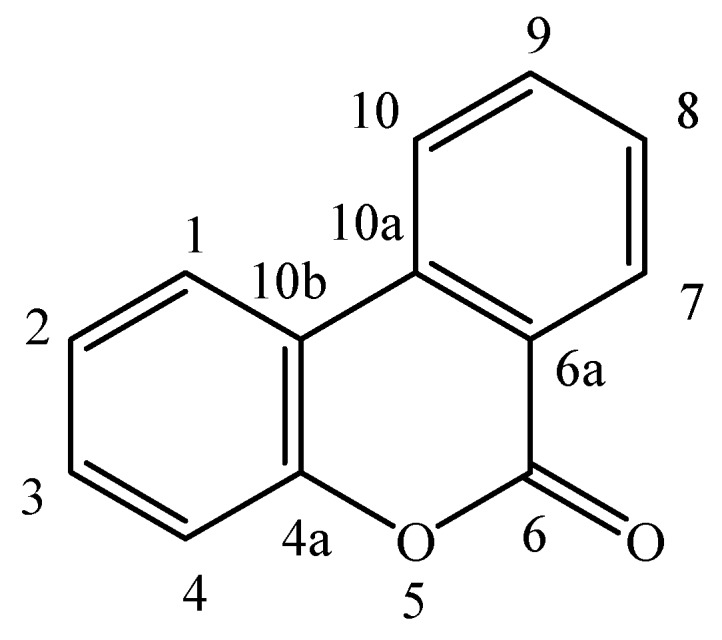
The basic skeleton of dibenzo-α-pyrones.
2. Occurrence
2.1. Dibenzo-α-pyrones from Fungi
Dibenzo-α-pyrones are mainly distributed in the Alternaria species and mycobionts. Other dibenzo-α-pyrone-producing fungi include Botrytis allii, Cephalosporium acremonium, Hyalodendriella sp. Ponipodef12, Microsphaeropsis olivacea, Penicillium verruculosum, and Phoma sp. TC 1674 (Table 1). From the biosynthetic pathway, fungal dibenzo-α-pyrones have a polyketide origin via acetyl-CoA and malonyl-CoA. They are usually toxic to plants and animals. Typical examples include alternariol (10), alternariol 9-methyl ether (11), botrallin (16), and 2-chloro-4,6-dihydro-1,7-dihydroxy-3,9-dimethoxy-1-methyl-1H-dibenzo[b,d]pyran-4,6-dione (TMC-264, 28). The structures of the dibenzo-α-pyrones from fungi are shown in Figure 2.
Table 1.
Occurrence of the dibenzo-α-pyrones in fungi.
| Dibenzo-α-pyrone | Fungal Species | Reference |
|---|---|---|
| Altenuene = ATL (1) | Endophytic Alternaria sp. isolated from Polygonum senegalense | [9] |
| Alternaria alternata | [10] | |
| Unidentified freshwater fungus belong to Tubeufiaceae | [19] | |
| Isoaltenuene (2) | Alternaria alternata | [20] |
| Unidentified freshwater fungus belong to Tubeufiaceae | [19] | |
| 2-Epialtenuene (3) | Alternaria alternata | [21] |
| Unidentified freshwater fungus belong to Tubeufiaceae | [19] | |
| 3-Epialtenuene (4) | Endophytic Alternaria sp. isolated from Polygonum senegalense | [9] |
| Neoaltenuene (5) | Alternaria alternata | [21] |
| Dehydroaltenuene A (6) | Unidentified freshwater fungus belong to Tubeufiaceae | [19] |
| Dehydroaltenuene B (7) | Unidentified freshwater fungus belong to Tubeufiaceae | [19] |
| Dihydroaltenuene A (8) | Unidentified freshwater fungus belong to Tubeufiaceae | [19] |
| Dihydroaltenuene B (9) | Unidentified freshwater fungus belong to Tubeufiaceae | [19] |
| Alternariol = AOH (10) | Endophytic Acremonium sp. isolated from Plantago lanceolata | [22] |
| Endophytic Alternaria sp. isolated from Polygonum senegalense | [9] | |
| Endophytic Alternaria no.28 isolated from Ginkgo biloba | [23] | |
| Endophytic Alternaria sp. PR-14 isolated from Paeonia delavayi | [24] | |
| Endophytic Alternaria sp. isolated from Datura stramonium | [25] | |
| Endophytic Alternaria sp. N.SBA10 isolated from Scutellaria baicalensis | [26] | |
| Alternaria alternata | [27] | |
| Alternaria alternata | [10] | |
| Endophytic Alternaria brassicicola ML-P08 isolated from Malus halliana | [28] | |
| Endophytic Alternaria tenuissima EN-192 isolated from Rhizophora stylosa | [29] | |
| Endophytic Colletotrichum sp. isolated from Aristolochia sp. | [30] | |
| Alternariol 9-methyl ether = AME = Djalonensone (11) | Endophytic Acremoniumsp. isolated from Plantago lanceolata | [22] |
| Endophytic Alternaria sp. isolated from Polygonum senegalense | [9] | |
| Endophytic Alternaria sp. PR-14 isolated from Paeonia delavayi | [24] | |
| Endophytic Alternaria sp. isolated from Datura stramonium | [25] | |
| Endophytic Alternaria sp. N.SBA10 isolated from Scutellaria baicalensis | [26] | |
| Alternaria alternata | [27] | |
| Alternaria alternata | [31] | |
| Alternaria alternata | [10] | |
| Endophytic Alternaria no.28 isolated from Ginkgo biloba | [23] | |
| Endophytic Alternaria brassicicola ML-P08 isolated from Malus halliana | [28] | |
| Endophytic Alternaria linicola isolated from Linum ustiatissimum | [32] | |
| Alternaria tenuis | [33] | |
| Alternariol 9-methyl ether = AME = Djalonensone (11) | Endophytic Alternaria tenuissima isolated from Acacia mangium | [34] |
| Endophytic Alternaria tenuissima EN-192 isolated from Rhizophora stylosa | [29] | |
| Endophytic Cephalosporium acremonium IFB-E007 isolated from Trachelospermum jasminoides | [35] | |
| Endophytic Colletotrhichum sp. isolated from Aristolochia sp. | [30] | |
| Endophytic Hyalodendriella sp. Ponipodef12 isolated from the hybrid ‘Neva’ of Populus deltoides × P. nigra | [12] | |
| Lachmum palmae | [36] | |
| Alternariol 9-methyl ether-3-O-sulfate (12) | Endophytic Alternaria sp. isolated from Polygonum senegalense | [9] |
| Alternariol 9-O-sulfate (13) | Endophytic Alternaria sp. isolated from Polygonum senegalense | [9] |
| 4-Hydroxyalternariol 9-methyl ether (14) | Endophytic Alternaria sp. isolated from Polygonum senegalense | [9] |
| Endophytic Alternaria sp. isolated from Datura stramonium | [25] | |
| Altertenuol = Altenuisol = Alternuisol (15) | Alternaria sp. | [37] |
| Alternaris tenuis | [38] | |
| Alternaris tenuis | [39,40] | |
| Alternaris tenuis | [41] | |
| Botrallin (16) | Botrytis allii | [42] |
| Endophytic Hyalodendriella sp. Ponipodef12 isolated from the hybrid ‘Neva’ of Populus deltoides × P. nigra | [12,43] | |
| Endophytic Microsphaeropsis olivacea isolated from Pilgerodendron uviferum | [13] | |
| Dehydroaltenusin (17) | Acremonium sp. | [44] |
| Alternaria tenuis | [45] | |
| Penicillium verruculosum | [46] | |
| Graphislactone A (18) | Mycobiont of Graphis scripta var. pulverulenta | [2] |
| Endophytic Cephalosporium acremonium IFB-E007 isolated from Trachelospermum jasminoides | [35] | |
| Endophytic Microsphaeropsis olivacea isolated from Pilgerodendron uviferum | [13] | |
| Graphislactone B (19) | Mycobiont of Graphis scripta var. pulverulenta | [2] |
| Graphislactone C (20) | Mycobiont of Graphis scripta var. pulverulenta | [2] |
| Graphislactone D (21) | Mycobiont of Graphis scripta var. pulverulenta | [2] |
| Graphislactone E (22) | Mycobiont of Graphis scripta | [3] |
| Mycobiont of Graphis prunicola | [3] | |
| Graphislactone F (23) | Mycobiont of Graphis prunicola | [3] |
| Graphislactone G (24) | Endophytic Cephalosporium acremonium IFB-E007 isolated from Trachelospermum jasminoides | [35] |
| Graphislactone H (25) | Endophytic Cephalosporium acremonium IFB-E007 isolated from Trachelospermum jasminoides | [35] |
| Palamriol A (26) | Lachmum palmae | [36] |
| Palmariol B (27) | Lachmum palmae | [36] |
| Endophytic Hyalodendriella sp. Ponipodef12 isolated from the hybrid ‘Neva’ of Populus deltoides × P. nigra | [12] | |
| TMC-264 (28) | Phoma sp. TC 1674 | [47] |
Figure 2.
Structures of dibenzo-α-pyrones isolated from fungi.
2.2. Dibenzo-α-pyrones from Plants
The dibenzo-α-pyrones from plants are listed in Table 2. One dibenzo-α-pyrone, namely djalonensone (11), was isolated from the roots of Anthocleista djalonensis (Loganiaceae). The authors postulated djalonensone to be a significant taxonomic marker of the plant species [48]. However, djalonensone is identical to alternariol 9-methyl ether (AME) which has been isolated from a series of fungi including pathogenic and endophytic fungi [1]. Thus, the significance of djalonensone (11) as an important taxonomic marker of the plant species should be reconsidered. The possibility that djalonensone (11) was produced by an endophytic fungus residing in the healthy roots of A. djalonensis, needs further investigation [49].
Table 2.
Occurrence of dibenzo-α-pyrones in plants.
| Dibenzo-α-pyrone | Plant species (Family) | Reference |
|---|---|---|
| Alternariol 9-methyl ether (11) | Anthocleista djalonensis (Loganiaceae) | [48] |
| Autumnariniol (29) | Eucomis autumnalis Graeb (Liliaceae) | [52] |
| Autumnariol (30) | Eucomis autumnalis Graeb (Liliaceae) | [52] |
| (2' S,3'R)-3,10-Dihydroxy-9-O-(6'- hydroxy-2'-hydroxymethyldihydrofuran-3-yl)-dibenzo[b,d]pyran-6-one (31) | Umtiza listerana (Caesalpiniaceae) | [50] |
| (2' S,3'R)-3,10-Dihydroxy-9-O-(5',6'-dihydroxy-2'-hydroxymethyldihydrofuran-3-yl)-dibenzo[b,d]pyran-6-one (32) | Umtiza listerana (Caesalpiniaceae) | [50] |
| Fasciculiferol (33) | Acacia fasciculifera (Mimosaceae) | [51] |
| Umtiza listerana (Caesalpiniaceae) | [50] | |
| Lysilactone A (34) | Lysimachia clethroides (Primulaceae) | [5] |
| Lysilactone B (35) | Lysimachia clethroides (Primulaceae) | [5] |
| Lysilactone C (36) | Lysimachia clethroides (Primulaceae) | [5] |
| 2,3,4,9,10-Pentahydroxy-6 H-dibenzo[b,d]pyran-6-one (37) | Chrozophora senegalensis (Euphorbiaceae) | [56] |
| Polygonum chinense (Polygonaceae) | [57] | |
| Sebastiania chamaelea (Euphorbiaceae) | [56] | |
| Tamarix nilotica (Tamaricaceae) | [58] | |
| Sabilactone (38) | Sabina vulgaris (Cupressaceae) | [54] |
| Sarolactone (39) | Hypericum japonicum (Guttiferae) | [55] |
| Urolithin A (40) | Trapa natans (Trapaceae) | [4] |
| Isourolithin A (41) | Trapa natans (Trapaceae) | [4] |
| Urolithin B (42) | Trapa natans (Trapaceae) | [4] |
| Urolithin C (43) | Caesalpinia sappan (Caesalpiniaceae) | [53] |
Three dibenzo-α-pyrones, namely (2'S,3'R)-3,10-dihydroxy-9-O-(6'-hydroxy-2'-hydroxymethyl- dihydrofuran-3-yl)-dibenzo[b,d]pyran-6-one (31), (2'S,3'R)-3,10-dihydroxy-9-O-(5',6'-dihydroxy-2'-hydroxymethyldihydrofuran-3-yl)-dibenzo[b,d]pyran-6-one (32), and fasciculiferol (33) were isolated from the heartwood of Umtiza listerana [50]. Fasciculiferol (33) was previously isolated from the heartwood of Acacia fasciculifera [51]. Two dibenzo-α-pyrones, autumnariniol (29) and autumnariol (30), were isolated from the bulbs of Eucomis autumnalis (Liliaceae) [52]. Four urolithins, namely urolithin A (40), isourolithin A (41), urolithin B (42) and urolithin C (43) were isolated from Trapa natans (Trapaceae) [4] and Caesalpinia sappan (Caesalpiniaceae) [53]. These urolithins (Figure 3) were also isolated from animal feces [6,7]. Other dibenzo-α-pyrones isolated from plants included sabilactone (38) from Sabina vulgaris [54] and sarolactone (39) from Hypericum japonicum [55]. The structures of the dibenzo-α-pyrones from plants are shown in Figure 4.
Figure 3.
Dibenzo-α-pyrones produced by transformation of intestinal bacteria.
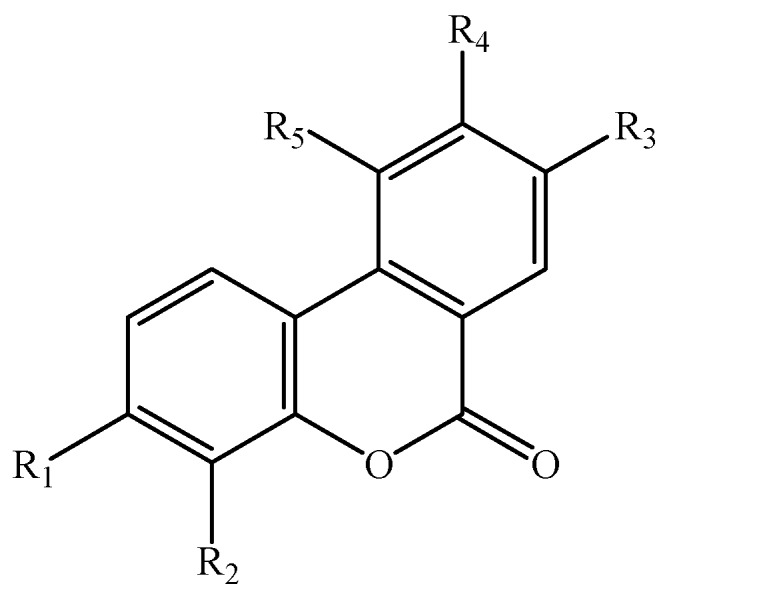
| Dibenzo-α-pyrone | R1 | R2 | R3 | R4 | R5 | Reference |
|---|---|---|---|---|---|---|
| Urolithin A (40) | OH | H | OH | H | H | [6] |
| Urolithin B (42) | OH | H | H | H | H | [6] |
| Urolithin C (43) | OH | H | OH | OH | H | [6] |
| Urolithin D (44) | OH | OH | OH | OH | H | [59] |
| Urolithin E (45) | OH | OH | OH | H | OH | [59] |
| Urolithin M-5 (46) | OH | OH | OH | OH | OH | [7] |
| Urolithin M-6 (47) | OH | H | OH | OH | OH | [7,59] |
| Urolithin M-7 (48) | OH | H | OH | H | OH | [7,11] |
| Isourolithin A (41) | OH | H | H | OH | H | [7] |
| Isourolithin B (49) | H | H | H | OH | H | [7] |
| 8-O-Methylurolithin A (50) | OH | H | OCH3 | H | H | [6] |
| 8,9-Di-O-methylurolithin C (51) | OH | H | OCH3 | OCH3 | H | [6] |
| 8,9-Di-O-methylurolithin D (52) | OH | OH | OCH3 | OCH3 | H | [6] |
Figure 4.
Structures of the dibenzo-α-pyrones from plants.
2.3. Dibenzo-α-pyrones Produced by Transformation of Intestinal Bacteria
A group of dibenzo-α-pyrones 40–52, namely urolithins with different phenolic hydroxylation patterns, have been isolated from animal feces. Ellagitannins and ellagic acid (EA) are plant secondary metabolites that have relevant antioxidant activities in vitro, potential cardiovascular protection, anticarcinogenic and anti-inflammatory effects [59,60,61]. These dibenzo-α-pyrones are important constituents in different foods including pomegranates, berries (i.e., strawberry, raspberry, blackberry, and camu-camu), nuts (i.e., walnuts, acorns, and chestnuts), muscadine grapes, oak-aged wines, medicinal plants and tisanes (i.e., geranium and oak leaves). They are not absorbed in the gut and are metabolized in vivo by the intestinal bacteria to produce a series of metabolites known as urolithins [62,63]. Some urolithins such as urolithins A (40), B (42) and C (43) as well as isourolithin A (41) were previously isolated from plants (Table 2) [4,53]. The structures of the isolated urolithins are shown in Figure 3.
2.4. Dibenzo-α-pyrones from Bacteria
Up to now, only one dibenzo-α-pyrone called murayalactone (53) has been isolated from Streptomyces murayamaensis [64]. The structure of murayalactone is shown in Figure 5.
Figure 5.
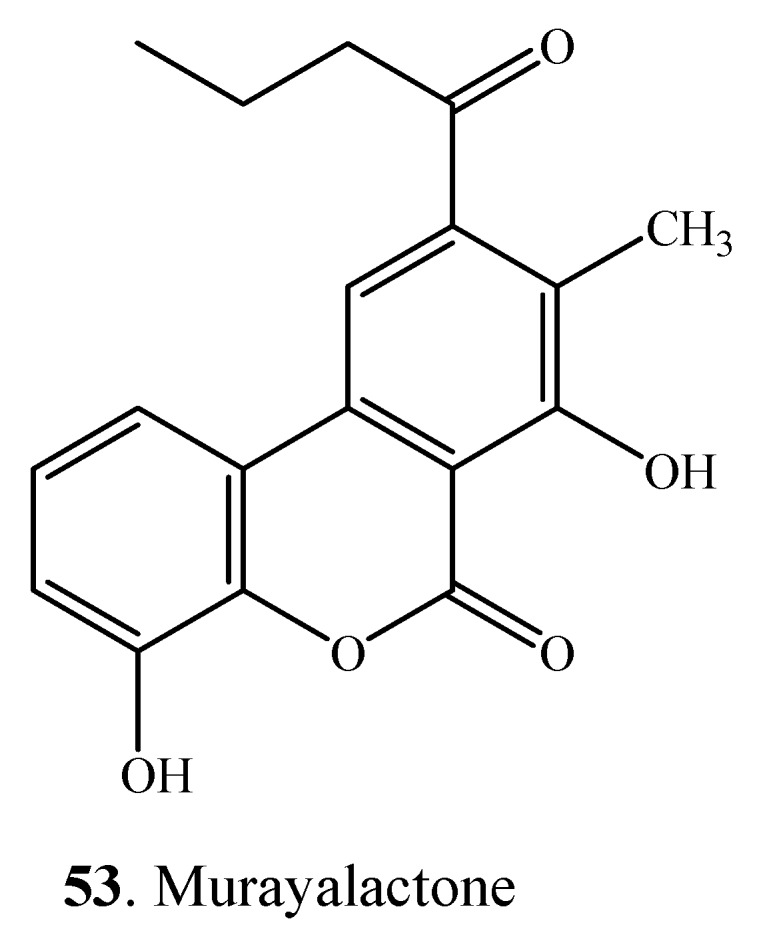
The structure of murayalactone (53).
3. Biosynthesis and Biotransformation
We know very little about the biosynthesis of dibenzo-α-pyrones in living organisms, including their genetics, biochemistry and biosynthetic pathways [2,25,65,66]. In plants, gallic acid (54), which is biosynthesized via the shikimate pathway [67], was considered as the precursor of ellagitannins [68]. The ellagitannins would be transformed into ellagic acid (55), and then into a series of urolithins (Scheme 1) [6,7,63]. However, in microorganisms, dibenzo-α-pyrones are biosynthesized via the polyketide pathway [3,25]. Polyketide synthase (PKS) is one of the postulated core enzymes in the biosynthesis of 6H-dibenzo[b,d]pyran-6-ones (i.e., alternariol, AME) in Alternaria alternata [66]. In a draft genome sequence of A. alternata, 10 putative PKS-encoding genes were identified. The timing of the expression of two PKS genes, pksJ and pksH, was found to correlate with the production of AOH and AME [66].
Scheme 1.
Proposed transformation from ellagic acid to urolithins by intestinal bacteria [6,7,63].
Alternariol (10) was first thought to be biosynthesized via norlichexanthone [65], which was ruled out later, and it was proven that alternariol (10) could be biosynthesized by simple cyclization and aromatization of a polyketide precursor [69]. After administration of [1-13C]acetate and [1,2-13C]acetate to cultured lichen mycobionts of Graphis spp., acetate units were incorporated into the 6H-dibenzo[b,d]pyran-6-one derivatives including alternariol (10), AME (11) and graphislactones A-F (18–23) [3]. Alternariol (10) could suffer oxidative demethylation at C-1, hydroxylation at C-4, and O-methylation at C-9 to lead formation of graphislactones E (22) and F (23). On the other hand, alternariol (10) could be transformed to graphislactones A-D (18–21) without demethylation via AME (11) [3]. The biosynthetic pathways of graphislactones A-F (18–23) in the cultured lichen mycobionts of Graphis spp. are shown in Scheme 2.
Scheme 2.
Biosynthetic pathways of graphislactones in the cultured lichen mycobionts [3].
Epigenetic modifiers, including DNA methyltransferase (DNMT) inhibitors (i.e., 5-azacytidine, abbreviated as 5-AC) and histone deacetylase (HDAC) inhibitors (i.e., suberoylanilide hydroxamic acid, abbreviated as SBHA) are useful to induce the expression of otherwise silent biosynthetic genes under standard laboratory conditions [70]. Supplementation of a DNMT inhibitor 5-AC or a HDAC inhibitor SBHA to the medium induced the production of alternariol (10), alternariol 9-methyl ether (11), 4-hydroxyalternariol 9-methyl ether (14) and altenusin (56) [25]. The proposed biosynthesis of the aromatic polyketides 10, 11, 14 and 56 involves the condensation of seven molecules of malonyl-CoA, followed by aldol-type cyclizations between C-2 and C-7, and C-8 and C-13, and the subsequent lactonization leads to alternariol (10) (Scheme 3). On the other hand, subsequent methylation of the C-9 hydroxyl group of alternariol (10) by a methyltransferase results in 4-hydroxyalternariol 9-methyl ether (14). Furthermore, the reduction of the C-9 carbonyl group of the heptaketide intermediate by a reductase, and subsequent aldol-type cyclization would produce a biphenyl. Methylation of the C-5 hydroxyl group, and the hydroxylation of C-5' would then lead to altenusin (56). The hypothetical biosynthetic pathways [25] of alternariol (10) and its derivatives 11, 14 in an endophytic fungus from Datura stramonium are shown in Scheme 3.
Scheme 3.
Hypothetical biosynthetic pathways of alternariol (10) and its derivatives (11, 14) in an endophytic fungus from Datura stramonium [25].
Urolithins include a family of metabolites of dibenzo-α-pyrone structures with different phenolic hydroxylation patterns. They are produced in different animals after the intake of ellagitannins and ellagic acid (EA) [71,72]. Ellagitannins are hydrolyzed to ellagic acid (55) in the acidic environment of the stomach by the action of the intestinal bacteria. The proposed transformation from ellagic acid to urolithins by the intestinal bacteria [6,7,63] is shown in Scheme 1.
4. Biological Activities and Functions
Dibenzo-α-pyrones and their derivatives with diverse chemical properties have been clarified (Figure 1, Figure 2, Figure 3, Figure 4 and Figure 5, Table 1 and Table 2). Some of them act as mycotoxins to humans and animals or as phytotoxins to plants. They have been examined to have a variety of biological activities and functions, which mainly include the cytotoxic, antioxidant, antiallergic, antimicrobial, antinematodal, and acetyl-cholinesterase inhibitory activities.
4.1. Toxicity on Human and Animals
The association of mycotoxins from Alternaria fungi with human and animal health is not a recent phenomenon. Alternaria toxins have been linked to a variety of adverse effects (i.e., genotoxic, mutagenic, and carcinogenic) on human and animal health [8]. Altenuene (1), alternariol (10), and alternariol 9-methyl ether (11) were studied for their toxicity to chickens. Addition of these compounds in chicken feed from sublethal to lethal levels progressively reduced feed efficiency, suppressed weight gain and increased internal haemorrhaging [27,73].
There were a few reports about the toxicity of Alternaria metabolites on brine shrimp (Artemia salina L.) [74,75]. The LC50 values of altenuene (1) and alternariol (10) were 375 and 100 µg/mL, respectively, to brine shrimp larvae by using the disk method of inoculation and an exposure period of 18 h [75]. Altenuene (1) and alternariol (10) along with alternariol 9-methyl ether (11) were also verified to be toxic to brine shrimp [74].
4.2. Cytotoxic Activity
Among Alternaria dibenzo-α-pyrones, alternariol (10) was the most active metabolite to have cytotoxic activity on L5178Y mouse lymphoma cells [9], as well as to have inhibitory activity on protein kinase and xanthine oxidase [28]. Further investigation showed that alternariol (10) was a topoisomerase I and II poison which might contribute to the impairment of DNA integrity in human colon carcinoma cells [73,76]. It induced cell death by activation of the mitochondrial pathway of apoptosis in human colon carcinoma cells [76]. Alternariol (10) and its 9-methyl ether (11) induced cytochrome P450 1A1 and apoptosis in murine heptatoma cells dependent on the aryl hydrocarbon receptor [77]. Other alternariol derivatives such as alternariol 9-methyl ether (11), alternariol 9-O-sulfate (13), and altenusin (56) were also screened to be cytotoxic [9].
Dehydroaltenusin (17), isolated from A. tenuis, was found to be a specific inhibitor of eukaryotic DNA polymerase α to show its strong cytotoxic activity on tumor cells [45,78]. This compound also exhibited strong inhibitory activity on mammalian DNA polymerase α in vitro [79]. It was further proved to abrogate cell proliferation of the cultured mammalian cells to show its potential as an effective chemotherapeutic agent against tumors [44].
Alternariol 9-methyl ether (11), graphislactone A (18), graphislactone G (24), and graphislactone H (25) from the endophytic fungus Cephalosporium acremonium IFB-E007 derived from Trachelospermum jasminoides showed pronounced activity against SW1116 cell with IC50 values of 14.0, 21.0, 12.0 and 8.5 μg/mL, respectively [35].
Urolithins derived from ellagic acid (55) were screened to have cytotoxic and anti-tumor activities. Urolithin A (40) inhibited cell growth of human colon cancer cell lines HT29 by inhibiting the canonical wnt signal pathway and interfere with β-catenin/TCF-dependent transcription [80], and inhibited growth of 22Rv1 prostate cancer cells by interfered with the expression of CYP1B1 protein [81]. Urolithin A (40), urolithin B (42), and 8-O-methylurolithin A (50) also showed antiproliferative effect on human bladder cancer T24 cells [82].
4.3. Phytotoxicity
The metabolites from fungal pathogens are usually toxic to plants and are called phytotoxins which are divided into host-specific [83,84] and host non-specific toxins [85,86]. Some Alternaria-derived dibenzo-α-pyrones were approved as the host-specific phytotoxins including altenuene (1), alternariol (10), alternariol 9-methyl ether (11), alternuisol (15), and dehydroaltenusin (17) [9,10,37,39,41,45].
4.4. Antioxidant Activity
Urolithin A (40), isourolithin A (41), and urolithin B (42) from the fruits of Trapa natans showed antioxidant activity. Among them, isourolithin A (41) showed the strongest, and urolithin B (42) showed weak antioxidative effect [4]. As ellagic acid and ellagitannins are extremely poorly absorbed in gut, urolithins appear to be responsible for biological activities related to the intake of ellagitannins. Most of urolithins (i.e., urolithins A, C, and D) exhibited antioxidant activity in a cell-based assay [6]. However, there have been contradictory reports on their antioxidant capacity [62,87]. Recently, urolithins were revealed to display both antioxidant and pro-oxidant activities depending on assay system and conditions by using oxygen radical absorbance capacity (ORAC) assay, three cell-based assays, copper-initiated pro-oxidant activity (CIPA) assay, and cyclic voltammetry. Urolithins were screened to be the strong antioxidants in the ORAC assay, but mostly pro-oxidants in cell-based assays [88]. The antioxidant activity of urolithins is very likely mediated exclusively by the hydrogen atom transfer (HAT) mechanism. The hydrogen atom is donated by the phenolic hydroxyl group [88].
4.5. Antiallergic Activity
Urolithin A (40), isourolithin A (41), and urolithin B (42), from the feces of Trogopterus xanthipes showed hyaluronidase inhibitory activities with IC50 values of 1.33, 1.07 and 2.33 mM, respectively that indicated their antiallergic activity [11]. TMC-264 (28) from the fungus Phoma sp. TC 1674 [47] selectively inhibited tyrosine phosphorylation of STAT6, and also inhibited the complex formation of phosphorylated STAT6 and its recognition sequence. Therefore, TMC-264 (28) would inhibit IL-4 signaling and would be useful in the treatment of allergic disease [47,89,90].
4.6. Other Bioactivities
Other biological activities of dibenzo-α-pyrones include antimicrobial, antimalarial, antinematodal activities as well as calmodulin-dependent, estrogenic and antiestrogenic, and acetylcholinesterase (AChE) inhibitory activities. Alternariol 9-methyl ether (11) from endophytic Alternaria spp. exhibited inhibitory activity on the appressorium formation of Magnaporthe grisea (M. oryzae) with IC50 value of 51.0 μg/mL [34]. Alternariol 9-methyl ether (11), botrallin (16) and palmariol B (27) from endophytic fungus Hyalodendriella sp. Ponipodef12 showed moderate antimicrobial activity [12,43].
2,3,4,9,10-Pentahydroxy-6H-dibenzo[b,d]pyran-6-one (37) from the plants Chrozophora senegalensis (Euphorbiaceae) and Sebastiania chamaelea (Euphorbiaceae) showed moderate antimalarial activity (IC50 > 10 μg/mL) on Plasmodium falciparum [56]. Alternariol 9-methyl ether (11), botrallin (16) and palmariol B (27) from endophytic fungus Hyalodendriella sp. Ponipodef12 also showed moderate antinematodal inhibitory activity on Caenorhabditis elegans [12].
Dehydroaltenusin (17) from Penicillium verruculosum IAM-13756 inhibited the calmodulin-dependent activity of myosin light chain kinase (MLCK) with IC50 value of 0.69 μM [46].
Both urolithins A (40) and B (42) from human feces exhibited estrogenic and antiestrogenic activities, which suggested that consumption of ellagitannin-containing foodstuffs such as pomegranate, walnuts, berries, and oak-aged wines may exert some proestrogenic/antiestrogenic effects [91].
Alternariol 9-methyl ether (11), botrallin (16) and palmariol B (27) from endophytic fungus Hyalodendriella sp. Ponipodef12 showed moderate AChE inhibitory activity [12]. Botrallin (16) from the endophytic fungus Microsphaeropsis olivacea was also screened to have AChE inhibitory activity with IC50 value as 6.1 μg/mL [13].
5. Conclusions and Future Perspectives
We have just clarified one part of the dibenzo-α-pyrones from fungi, plants and bacteria. The remaining dibenzo-α-pyrones in bioorganisms need to be further identified. In recent years, more and more dibenzo-α-pyrones have been isolated from plant endophytic fungi. These endophytic fungi could be the rich sources of biologically active compounds that are indispensable for medicinal and agricultural applications [92,93]. In most cases, biological activities, structure-activity relationships, and modes of action of dibenzo-α-pyrones were only primarily investigated.
The potential applications of dibenzo-α-pyrones as antitumor agents, antiallergics, antioxidants, and antimicrobials have attracted considerable interest within the pharmaceutical community. Chemical syntheses have been achieved for a few bioactive dibenzo-α-pyrones such as altenuene (1) [94], isoaltenuene (2) [94], neoaltenuene (5) [95], alternariol (10) [96], alternariol 9-methyl ether (11) [96], altertenuol (15) [97], dehydroaltenusin (17) [98], graphislactones A (18), C (20), D (21) and H (25) [99], TMC-264 (28) [90], lysilactone A (34) [5], urolithins A-C (40, 42 and 43) [100], and urolithin M-7 (48) [101]. In addition, some dibenzo-α-pyrones are the important precursors of many synthetic drugs [14,15,16,17,18].
With comprehensive understanding of the biosynthetic pathways of some dibenzo-α-pyrones in the next few years, we may be able to effectively not only increase the yields of bioactive dibenzo-α-pyrones, but also block the biosynthesis of some toxic dibenzo-α-pyrones (i.e., phytotoxins and mycotoxins) [1].
Acknowledgements
This work was co-financed by the grants from the National Basic Research Program of China (2010CB126105), the Hi-Tech R&D Program of China (2011AA10A202), and the National Natural Science Foundation of China (31271996).
Author Contributions
Ziling Mao performed bibliographic researches, drafted and corrected manuscript. Weibo Sun, Linyun Fu and Haiyu Luo participated in the discussions and supported manuscript corrections. Daowan Lai reviewed manuscript and helped to revised it. Ligang Zhou conceived the idea, designed the structure of review article, supervised manuscript drafting, and revised manuscript.
Conflicts of Interest
The authors declare no conflict of interest.
References
- 1.Lou J., Fu L., Peng Y., Zhou L. Metabolites from Alternaria fungi and their bioactivities. Molecules. 2013;18:5891–5935. doi: 10.3390/molecules18055891. [DOI] [PMC free article] [PubMed] [Google Scholar]
- 2.Tanahashi T., Kuroishi M., Kuwahara A., Nagakura N., Hamada N. Four phenolics from the cultured lichen mycobiont of Graphis scripta var. pulverulenta. Chem. Pharm. Bull. 1997;45:1183–1185. doi: 10.1248/cpb.45.1183. [DOI] [Google Scholar]
- 3.Tanahashi T., Takenaka Y., Nagakura N., Hamada N. 6H-Dibenzo[b,d]pyran-6-one derivatives from the cultured lichen mycobionts of Graphis spp. and their biosynthetic origin. Phytochemistry. 2003;62:71–75. doi: 10.1016/S0031-9422(02)00402-8. [DOI] [PubMed] [Google Scholar]
- 4.Shirataki Y., Toda S. Antioxidative effects of dibenzo-α-pyrones in fruits of Trapa natans on lipid peroxidation. Nat. Med. 2001;55:247–250. [Google Scholar]
- 5.Liang D., Luo H., Liu Y.-F., Hao Z.-Y., Wang Y., Zhang C.-L., Zhang Q.-J., Chen R.-Y., Yu D.-Q. Lysilactones A-C, three 6H-dibenzo[b,d]pyran-6-one glycosides from Lysimachia clethroides, total synthesis of lysilactone A. Tetrahedron. 2013;69:2093–2097. doi: 10.1016/j.tet.2013.01.029. [DOI] [Google Scholar]
- 6.Bialonska D., Kasimsetty S.G., Khan S.I., Ferreira D. Urolithins, intestinal microbial metabolites of pomegranate ellagitannins, exhibit potent antioxidant activity in a cell-based assay. J. Agric. Food Chem. 2009;57:10181–10186. doi: 10.1021/jf9025794. [DOI] [PubMed] [Google Scholar]
- 7.Gonzalez-Barrio R., Truchado P., Ito H., Espin J.C., Tomas-Barberan F.A. UV and MS identification of urolithins and nasutins, and bioavailable metabolites of ellagic acid in different mammals. J. Agric. Food Chem. 2011;59:1152–1162. doi: 10.1021/jf103894m. [DOI] [PubMed] [Google Scholar]
- 8.Moreno M.A.P., Alonso I.G., Martin de Santos R., Lacarra T.G. The role of the genus Alternaria. in mycotoxin production and human diseases. Nutr. Hosp. 2012;27:1772–1781. doi: 10.3305/nh.2012.27.6.6017. [DOI] [PubMed] [Google Scholar]
- 9.Aly A.H., Edrada-Ebel R., Indriani I.D., Wray V., Muller W.E.G., Totzke F., Zirrgiebel U., Schachtele C., Kubbutat M.H.G., Lin W.H., et al. Cytotoxic metabolites from the fungal endophyte Alternaria sp. and their subsequent detection in its host plant Polygonum senegalense. J. Nat. Prod. 2008;71:972–980. doi: 10.1021/np070447m. [DOI] [PubMed] [Google Scholar]
- 10.Watanabe I., Kakishima M., Adachi Y., Nakajima H. Potential mycotoxin productivity of Alternaria alternata isolated from garden trees. Mycotoxins. 2007;57:3–9. doi: 10.2520/myco.57.3. [DOI] [Google Scholar]
- 11.Jeong S.-J., Kim N.-Y., Kim D.-H., Kang T.-H., Ahn N.-H., Miyamoto T., Higuchi R., Kim Y.-C. Hyaluronidase inhibitory active 6H-dibenzo[b,d]pyran-6-ones from the feces of Trogopterus xanthipes. Planta Med. 2000;66:76–77. doi: 10.1055/s-0029-1243114. [DOI] [PubMed] [Google Scholar]
- 12.Meng X., Mao Z., Lou J., Xu L., Zhong L., Peng Y., Zhou L., Wang M. Benzopyranones from the endophytic fungus Hyalodendriella sp. Ponipodef12 and their bioactivities. Molecules. 2012;17:11303–11314. doi: 10.3390/molecules171011303. [DOI] [PMC free article] [PubMed] [Google Scholar]
- 13.Hormazabal E., Schmeda-Hirschmann G., Astudillo L., Rodriguez J., Theoduloz C. Metabolites from Microsphaeropsis olicacea, an endophytic fungus of Pilgerodendron ufiferum. Z. Naturforsch. C. 2005;60:11–21. doi: 10.1515/znc-2005-1-203. [DOI] [PubMed] [Google Scholar]
- 14.Teske J., Deiters A. A cyclotrimerization route to cannabinois. Org. Lett. 2008;10:2195–2198. doi: 10.1021/ol800589e. [DOI] [PubMed] [Google Scholar]
- 15.Edwards J.P., West S.J., Marschke K.B., Mais D.E., Gottardis M.M., Jones T.K. 5-Aryl-1,2-dihydro-5H-chromeno[3,4-f]quinolines as potent, orally active, nonsteroidal progesterone receptor agonists: The effect of D-ring substituents. J. Med. Chem. 1998;41:303–310. doi: 10.1021/jm9705770. [DOI] [PubMed] [Google Scholar]
- 16.Coghlan M.J., Kym P., Elmore S.W., Wang A.X., Luly J.R., Wilcox D., Stashko M., Lin C.-W., Miner J., Tyree C., et al. Synthesis and characterization of non-steroidal ligands for the glucocorticoid receptor: Selective quinoline derivatives with prednisolone-equivalent functional activity. J. Med. Chem. 2001;44:2879–2885. doi: 10.1021/jm010228c. [DOI] [PubMed] [Google Scholar]
- 17.Schmidt J.M., Tremblay G.B., Page M., Mercure J., Feher M., Dunn-Dufault R., Peter M.G., Redden P.R. Synthesis and evaluation of a novel nonsteroidal-specific endothelial cell proliferation inhibitor. J. Med. Chem. 2003;46:1289–1292. doi: 10.1021/jm034007d. [DOI] [PubMed] [Google Scholar]
- 18.Sashidhara K.V., Kumar A., Kumar M., Sonkar R., Bhatia G., Khanna A.K. Novel coumarin derivatives as potential antidyslipidemic agents. Bioorg. Med. Chem. Lett. 2010;20:4248–4251. doi: 10.1016/j.bmcl.2010.05.023. [DOI] [PubMed] [Google Scholar]
- 19.Jiao P., Gloer J.B., Campbell J., Shearer C.A. Altenuene derivatives from an unidentified freshwater fungus in the family Tubeufiaceae. J. Nat. Prod. 2006;69:612–615. doi: 10.1021/np0504661. [DOI] [PMC free article] [PubMed] [Google Scholar]
- 20.Visconti A., Bottalico A., Solfrizzo M., Palmisano F. Isolation and structure elucidation of isoaltenuene, a new metabolite of Alternaria alternata. Mycotoxin Res. 1989;5:69–76. doi: 10.1007/BF03192124. [DOI] [PubMed] [Google Scholar]
- 21.Bradburn N., Coker R.D., Blunden G., Turner C.H., Crabb T.A. 5'-Epialtenuene and neoaltenuene, dibenzo-α-pyrones from Alternaria alternata cultured on rice. Phytochemistry. 1994;35:665–669. doi: 10.1016/S0031-9422(00)90583-1. [DOI] [Google Scholar]
- 22.Hussain H., Krohn K., Ullah Z., Draeger S., Schulz B. Bioactive chemical constituents of two endophytic fungi. Biochem. Syst. Ecol. 2007;35:898–900. doi: 10.1016/j.bse.2007.04.011. [DOI] [Google Scholar]
- 23.Qin J.-C., Zhang Y.-M., Hu L., Ma Y.-T., Gao J.-M. Cytotoxic metabolites produced by Alternaria no.28, an endophytic fungus isolated from Ginkgo biloba. Nat. Prod. Commun. 2009;4:1473–1476. [PubMed] [Google Scholar]
- 24.Wu S., Chen Y., Li Z., Yang L., Li S. Metabolites of the endophytic fungus Alternaria sp. PR-14 of Paeonia delavayi. Nat. Prod. Res. Dev. 2011;23:850–852. [Google Scholar]
- 25.Sun J., Awakawa T., Noguchi H., Abe I. Induced production of mycotoxins in an endophytic fungus from the medicinal plant Datura stramonium L. Bioorg. Med. Chem. Lett. 2012;22:6397–6400. doi: 10.1016/j.bmcl.2012.08.063. [DOI] [PubMed] [Google Scholar]
- 26.Zheng Z., Liu Y., Fan L. Antioxidant activity and structure identification of metabolites of an endophytic fungus Alternaria. sp. N.SBA10 isolated from Scutellaria baicalensis. Mycosystema. 2012;31:917–923. [Google Scholar]
- 27.Griffin G.F., Chu F.S. Toxicity of the Alternaria metabolites alternariol, alternariol methyl ether, altenuene, and tenuazonic acid in the chicken embryo assay. Appl. Environ. Microbiol. 1983;46:1420–1422. doi: 10.1128/aem.46.6.1420-1422.1983. [DOI] [PMC free article] [PubMed] [Google Scholar]
- 28.Gu W. Bioactive metabolites from Alternaria brassicicola ML-P08, an endophytic fungus residing in Malus halliana. World J. Microbiol. Biotechnol. 2009;25:1677–1683. doi: 10.1007/s11274-009-0062-y. [DOI] [Google Scholar]
- 29.Sun H., Gao S., Li X., Li C., Wang B. Chemical constituents of marine mangrove-derived endophytic fungus Alternaria tenuissima EN-192. Chin. J. Oceanol. Limnol. 2013;31:464–470. doi: 10.1007/s00343-013-2106-2. [DOI] [Google Scholar]
- 30.Yang Z., Yin Y., Wang Z., Yang T., Chen D. Cytotoxic metabolites of endophytic fungus Colletotrichum sp. from Aristolochia sp. Nat. Prod. Res. Dev. 2012;24:329–332. [Google Scholar]
- 31.An Y.-H., Zhao T.-Z., Miao J., Liu G.-T., Zheng Y.-Z., Xu Y.-M., van Etten R.L. Isolation, identification, and mutagenicity of alternariol monomethyl ether. J. Agric. Food Chem. 1989;37:1341–1343. doi: 10.1021/jf00089a029. [DOI] [Google Scholar]
- 32.Evans N., Mcroberts N., Hill R.A., Marshall G. Phytotoxin production by Alternaria linicola and phytoalexin production by the linseed host. Ann. Appl. Biol. 1996;129:415–431. doi: 10.1111/j.1744-7348.1996.tb05765.x. [DOI] [Google Scholar]
- 33.Pero R.W., Main C.E. Chlorosis of tobacco induced by alternariol monomethyl ether produced by Alternaria tenuis. Phytopathology. 1970;60:1570–1573. doi: 10.1094/Phyto-60-1570. [DOI] [Google Scholar]
- 34.Jeon Y.-T., Ryu K.-H., Kang M.-K., Park S.-H., Yun H., Qt P., Kim S.-U. Alternariol monomethyl ether and α,β-dehydrocurvularin from endophytic fungi Alternaria spp. inhibit appressorium formation of Magnaporthe grisea. J. Korean Soc. Appl. Biol. Chem. 2010;53:39–42. [Google Scholar]
- 35.Zhang H.-W., Huang W.-Y., Song Y.-C., Chen J.-R., Tan R.-X. Four 6H-dibenzo[b,d]pyran-6-one derivatives produced by the endophyte Cephalosporium acremonium IFB-E007. Helv. Chim. Acta. 2005;88:2861–2864. doi: 10.1002/hlca.200590228. [DOI] [Google Scholar]
- 36.Matumoto T., Hosoya T., Shigemori H. Palmariols A and B, two new chlorinated dibenzo-α-pyrones from discomycete Lachnum palmae. Heterocycles. 2010;81:1231–1237. doi: 10.3987/COM-10-11919. [DOI] [Google Scholar]
- 37.Chu F.S. Isolation of altenuisol and altertoxins I and II, minor mycotoxins elaborated by Alternaria. J. Am. Oil Chem. Soc. 1981;58:1006–1008. doi: 10.1007/BF02679313. [DOI] [Google Scholar]
- 38.Rosett T., Sankhala R.H., Stickings C.E., Taylor M.E.U., Thomas R. Studies in the biochemistry of micro-organisms. 103. Metabolites of Alternaria tenuis Auct.: Culture filtrate products. Biochem. J. 1957;67:390–400. doi: 10.1042/bj0670390. [DOI] [PMC free article] [PubMed] [Google Scholar]
- 39.Thomas R. Studies in the biosynthesis of fungal metabolites IV. Alternariol monomethyl ether and its relation to other phenolic metabolites of Alternaria tenuis. Biochem. J. 1961;80:234–240. doi: 10.1042/bj0800234. [DOI] [PMC free article] [PubMed] [Google Scholar]
- 40.Thomas R., Nemecek G., Podlech J. Structure confirmation of altertenuol. Nat. Prod. Res. 2013;27:2053–2054. doi: 10.1080/14786419.2013.819509. [DOI] [PubMed] [Google Scholar]
- 41.Pero R.W., Harvan D., Blois M.C. Isolation of the toxin, altenuisol, from the fungus, Alternaria tenuis Auct. Tetrahedron Lett. 1973;12:945–948. doi: 10.1016/S0040-4039(00)72458-0. [DOI] [Google Scholar]
- 42.Kameda K., Aoki H., Namiki M. An alternative structure for botrallin a metabolite of Botrytis allii. Tetrahedron Lett. 1974;1:103–106. doi: 10.1016/S0040-4039(01)82147-X. [DOI] [Google Scholar]
- 43.Zhong L., Xu L., Meng X., Peng Y., Chen Y., Sui P., Wang M., Zhou L. Botrallin from the endophytic fungus Hyalodendriella sp. Ponipodef12 and its antimicrobial activity. Afr. J. Biotechnol. 2011;10:18174–18178. [Google Scholar]
- 44.Murakami-Nakai C., Maida N., Yonezawa Y., Kuriyama I., Kamisuki S., Takahashi S., Sugawara F., Yoshida H., Sakaguchi K., Mizushina Y. The effects of dehydroaltenusin, a novel mammalian DNA polymerase α inhibitor, on cell proliferation and cell cycle progression. Biochim. Biophys. Acta. 2004;1674:193–199. doi: 10.1016/j.bbagen.2004.06.016. [DOI] [PubMed] [Google Scholar]
- 45.Maeda N., Kokai Y., Ohtani S., Sahara H., Kuriyama I., Kamisuki S., Takahashi S., Sakaguchi K., Sugawara F., Yoshida H. Anti-tumor effects of dehydroaltenusin, a specific inhibitor of mammalian DNA polymerase α. Biochem. Biophys. Res. Commun. 2007;352:390–396. doi: 10.1016/j.bbrc.2006.11.021. [DOI] [PubMed] [Google Scholar]
- 46.Nakanishi S., Toki S., Saitoh Y., Tsukuda E., Kawahara K., Ando K., Matsuda Y. Isolation of myosin light chain kinase inhibitors from microorganisms: Dehydroaltenusin, altenusin, atrovenetinone, and cyclooctasulfur. Biosci. Biotech. Biochem. 1995;59:1333–1335. doi: 10.1271/bbb.59.1333. [DOI] [PubMed] [Google Scholar]
- 47.Sakurai M., Nishio M., Yamamoto K., Okuda T., Kawano K., Ohnuki T. TMC-264, a novel antiallergic heptaketide produced by the fungus Phoma sp. TC 1674. Org. Lett. 2003;5:1083–1085. doi: 10.1021/ol034125v. [DOI] [PubMed] [Google Scholar]
- 48.Onocha P., Okopie D.A., Connolly J.D., Roycroft D.S. Monoterpene diol, iridoid glucoside and dibenzo-α-pyrone from Anthocleista djalonensis. Phytochemistry. 1995;40:1183–1189. doi: 10.1016/0031-9422(95)00121-M. [DOI] [Google Scholar]
- 49.Zhao J., Shan T., Mou Y., Zhou L. Plant-derived bioactive compounds produced by endophytic fungi. Mini-Rev. Med. Chem. 2011;11:159–168. doi: 10.2174/138955711794519492. [DOI] [PubMed] [Google Scholar]
- 50.Burger A.P.N., Brandt E.V., Roux D.G. O-(Dihydrobenzofuranyl)-dibenzo-α-pyrones from Umtiza listerana. Phytochemistry. 1983;22:2813–2817. doi: 10.1016/S0031-9422(00)97703-3. [DOI] [Google Scholar]
- 51.Van Heerden F.R., Brandt E.V., Ferreira D., Roux D.G. Metabolites from the purple heartwoods of the Mimosoideae. Part 4. Acacia fasciculifera F. Muell ex. Benth: Fasciculiferin, fasciculiferol, and the synthesis of 7-aryl- and 7-flavanylpeltogynoids .J. Chem. Soc. Perkin Trans. 1. 1981;9:2483–2490. [Google Scholar]
- 52.Sidwell W.T.L., Fritz H., Tamm C. Autumnariol and autumnariniol, two new dibenzo-α-pyrones from Eucomis autumnalis. Detection of long-range coupling over six bonds in the NMR spectra. Helv. Chim. Acta. 1971;54:207–215. doi: 10.1002/hlca.19710540118. [DOI] [Google Scholar]
- 53.Chen Y.-P., Liu L., Zhou Y.-H., Wen J., Jiang Y., Tu P.-F. Chemical constituents from sappan lignum. J. Chin. Pharm. Sci. 2008;17:82–86. [Google Scholar]
- 54.Fang S., Gu Y., Yu H., Musadillin S. The antitumor constituents from Sabina vulgaris Ant. Acta. Bot. Sin. 1989;31:382–388. [Google Scholar]
- 55.Ishiguro K., Yamaki M., Kashihara M., Takagi S., Isoi K. A chromene from Hypericum japonicum. Phytochemistry. 1990;29:1010–1011. doi: 10.1016/0031-9422(90)80073-P. [DOI] [Google Scholar]
- 56.Garcia-Alvarez M.-C., Moussa I., Njomnang Soh P., Nongonierma R., Abdoulaye A., Nicolau-Travers M.-L., Fabre A., Wdzieczak-Bakala J., Ahond A., Poupat C., et al. Both plants Sebastiania chamaelea from Niger and Chrozophora senegalensis from Senegal used in African traditional medicine in malaria treatment share a same active principle. J. Ethnopharmacol. 2013;149:676–684. doi: 10.1016/j.jep.2013.07.024. [DOI] [PubMed] [Google Scholar]
- 57.Xie X., Wu P., Lin L., Liu M., Wei X. Identification of chemical constituents from Polygonum chinense Linn. J. Trop. Subtrop. Bot. 2007;15:450–454. [Google Scholar]
- 58.Nawwar M.A.M., Souleman A.M.A. 3,4,8,9,10-Pentahydroxy-dibenzo[b,d]pyran-6-one from Tamarix nilotica. Phytochemistry. 1984;23:2966–2967. doi: 10.1016/0031-9422(84)83057-5. [DOI] [Google Scholar]
- 59.Gil M.I., Tomás-Barberán F.A., Hess-Pierce B., Holcroft D.M., Kader A.A. Antioxidant activity of pomegranate juice and its relationship with phenolic composition and processing. J. Agric. Food Chem. 2000;48:4581–4589. doi: 10.1021/jf000404a. [DOI] [PubMed] [Google Scholar]
- 60.Larrosa M., García-Conesa M.T., Espín J.C., Tomás-Barberán F.A. Ellagitannins, ellagic acid and vascular health. Mol. Aspects Med. 2010;31:513–539. doi: 10.1016/j.mam.2010.09.005. [DOI] [PubMed] [Google Scholar]
- 61.Landete J.M. Ellagitannins, ellagic acid and their derived metabolites. A review about source, metabolism, function and health. Food Res. Int. 2011;44:1150–1160. doi: 10.1016/j.foodres.2011.04.027. [DOI] [Google Scholar]
- 62.Cerda B., Espin J.C., Parra S., Martinez P., Tomas-Barberan F.A. The potent in vitro antioxidant ellagitannins from pomegranate juice are metabolized into bioavailable but poor antioxidant hydroxyl-6H-dibenzopyran-6-one derivatives by the colonic microflora of healthy humans. Eur. J. Nutr. 2004;43:205–220. doi: 10.1007/s00394-004-0461-7. [DOI] [PubMed] [Google Scholar]
- 63.Garcia-Villalba R., Beltran D., Espin J.C., Selma M.V., Tomas-Barberan F.A. Time course production of urolithins from ellagic acid by human gut microbiota. J. Agric. Food Chem. 2013;61:8797–8806. doi: 10.1021/jf402498b. [DOI] [PubMed] [Google Scholar]
- 64.Melville C., Gould S.J. Murayalactone, a dibenzo-α-pyrone from Streptomyces murayamaensis. J. Nat. Prod. 1994;57:597–601. doi: 10.1021/np50107a005. [DOI] [PubMed] [Google Scholar]
- 65.Stinson E.E., Wise W.B., Moreau M., Jurewicz A.J., Pfeffer P.E. Alternariol: Evidence for biosynthesis via norlichexanthone. Can. J. Chem. 1986;64:1590–1594. doi: 10.1139/v86-263. [DOI] [Google Scholar]
- 66.Saha D., Fetzner R., Burkhardt B., Podlech J., Metzler M., Dang H., Lawrence C., Fischer R. Identification of a polyketide synthase required for alternariol (AOH) and alternariol-9-methyl ether (AME) formation in Alternaria alternata. PLoS One. 2012;7:e40564. doi: 10.1371/journal.pone.0040564. [DOI] [PMC free article] [PubMed] [Google Scholar]
- 67.Werner R.A., Sossmann A., Schwarz C., Bacher A., Schmidt H.-L., Eisenreich W. Biosynthesis of gallic acid in Rhus typhia: Discrimination between alternative pathways from natural oxygen isotope abundance. Phytochemistry. 2004;65:2809–2813. doi: 10.1016/j.phytochem.2004.08.020. [DOI] [PubMed] [Google Scholar]
- 68.Niemetz R., Gross G.G. Enzymology of gallotannin and ellagitannin biosynthesis. Phytochemistry. 2005;66:2001–2011. doi: 10.1016/j.phytochem.2005.01.009. [DOI] [PubMed] [Google Scholar]
- 69.Dasenbrock J., Simpson T.J. Alternariol is not biosynthesized via norlichexanthone. J. Chem. Sco. Chem. Commun. 1987;1987:1235–1236. doi: 10.1039/c39870001235. [DOI] [Google Scholar]
- 70.Fisch K.M., Gillaspy A.F., Gipson M., Henrikson J.C., Hoover A.R., Jackson L., Najar F.Z., Wagele H., Cichewicz R.H. Chemical induction of silent biosynthetic pathway transcription in Aspergillus niger. J. Ind. Microbiol. Biotechnol. 2009;36:1199–1213. doi: 10.1007/s10295-009-0601-4. [DOI] [PubMed] [Google Scholar]
- 71.Cerda B., Tomas-Barberan F.A., Espin J.C. Metabolism of antioxidant and chemopreventive ellagitannins from strawberries, raspberries, walnuts, and oak-aged wine in humans: Identification of biomarkers and individual variability. J. Argic. Food Chem. 2005;53:227–235. doi: 10.1021/jf049144d. [DOI] [PubMed] [Google Scholar]
- 72.Espin J.C., Gonzalez-Barrio R., Cerda B., Lopez-Bote C., Tomas-Barberan F.A. Iberian pig as a model to clarify obscure points in the bioavailability and metabolism of ellagitannins in humans. J. Agric. Food Chem. 2007;55:10476–10485. doi: 10.1021/jf0723864. [DOI] [PubMed] [Google Scholar]
- 73.Ostry V. Alternaria mycotoxins: An overview of chemical characterization, producers, toxicity, analysis and occurrence in foodstuffs. World Mycotoxin J. 2008;1:175–188. doi: 10.3920/WMJ2008.x013. [DOI] [Google Scholar]
- 74.Zajkowski P., Grabarkiewicz-Szcesna J., Schmidt R. Toxicity of mycotoxins produced by four Alternaria species to Artemia salina larvae. Mycotoxin Res. 1991;7:11–15. doi: 10.1007/BF03192158. [DOI] [PubMed] [Google Scholar]
- 75.Panigrahi S., Dallin S. Toxicity of the Alternaria spp. metabolites, tenuazonic acid, alternariol, altertoxin-I, and alternariol monomethyl ether to brine shrimp (Artemia. salina L.) larvae. J. Sci. Food Agric. 1994;66:493–496. doi: 10.1002/jsfa.2740660411. [DOI] [Google Scholar]
- 76.Bensassi F., Gallerne C., Sharaf El Dein O., Hajlaoui M.R., Bacha H., Lemaire C. Cell death induced by the Alternaria mycotoxin alternariol. Toxicol. In Vitro. 2012;26:915–923. doi: 10.1016/j.tiv.2012.04.014. [DOI] [PubMed] [Google Scholar]
- 77.Schreck I., Deigendesch U., Burkhardt B., Marko D., Weiss C. The Alternaria mycotoxins alternariol and alternariol methyl ether induce cytochrome P450 1A1 and apoptosis in murine hepatoma cells dependent on the aryl hydrocarbon receptor. Arch. Toxicol. 2012;86:625–632. doi: 10.1007/s00204-011-0781-3. [DOI] [PubMed] [Google Scholar]
- 78.Mizushina Y., Maeda N., Kuriyama I., Yoshida H. Dehydroalternusin is a specific inhibitor of mammalian DNA polymerase α. Expert Opin. Inv. Drug. 2011;20:1523–1534. doi: 10.1517/13543784.2011.619977. [DOI] [PubMed] [Google Scholar]
- 79.Mizushina Y., Kamisuki S., Mizuno T., Takemura M., Asahara H., Linn S., Yamaguchi T., Matsukage A., Hanaoka F., Yoshida S., et al. Dehydroaltenusin, a mammalian DNA polymerase a inhibitor. J. Biol. Chem. 2000;275:33957–33961. doi: 10.1074/jbc.M006096200. [DOI] [PubMed] [Google Scholar]
- 80.Selma M.V., Espin J.C., Tomas-Barberan F.A. Interaction between phenolics and gut microbiota: Role in human health. J. Agric. Food Chem. 2009;57:6485–6501. doi: 10.1021/jf902107d. [DOI] [PubMed] [Google Scholar]
- 81.Kasimsetty S.G., Bialonska D., Reddy M.K., Thornton C., Willett K.L., Ferreira D. Effects of pomergranate chemical constituents/intestinal microbial metabolites on CYP1B1 in 22Rv1 prostate cancer cells. J. Agric. Food Chem. 2009;57:10636–10644. doi: 10.1021/jf902716r. [DOI] [PubMed] [Google Scholar]
- 82.Qiu Z., Zhou B., Jin L., Yu H., Liu L., Liu Y., Qin C., Xie S., Zhu F. In vitro antioxidant and antiproliferative effects of ellagic acid and its colonic metabolite, urolithins, on human baldder cancer T24 cells. Food Chem. Toxicol. 2013;59:428–437. doi: 10.1016/j.fct.2013.06.025. [DOI] [PubMed] [Google Scholar]
- 83.Graniti A. Phytotoxins and their involvement in plant diseases. Experientia. 1991;47:751–755. doi: 10.1007/BF01922453. [DOI] [Google Scholar]
- 84.Pedras M.S.C., Biesenthal C.J., Zaharia I.L. Comparison of the phytotoxic activity of the phytotoxin destruxin B and four natural analogs. Plant Sci. 2000;156:185–192. doi: 10.1016/S0168-9452(00)00253-3. [DOI] [PubMed] [Google Scholar]
- 85.Montemurro N., Visconti A. Alternaria Metabolites—Chemical and Biological Data. In: Chelkowski J., Visconti A., editors. Alternaria: Biology, Plant Disease and Metabolites. Elsevier; Amsterdam, The Netherlands: 1992. pp. 449–557. [Google Scholar]
- 86.Tsuge T., Harimoto Y., Akimitsu K., Ohtani K., Kodama M., Akagi Y., Egusa M., Yamamoto M., Otani H. Host-selective toxins produced by the plant pathogenic fungus Alternaria alternata. FEMS Microbiol. Rev. 2013;37:44–66. doi: 10.1111/j.1574-6976.2012.00350.x. [DOI] [PubMed] [Google Scholar]
- 87.Ishimoto H., Shibata M., Myojin Y., Ito H., Sugimoto Y., Tai A., Hatano T. In vivo anti-inflammatoy and antioxidant properties of ellagitannin metabolite urolithin A. Bioorg. Med. Chem. Lett. 2011;21:5901–5904. doi: 10.1016/j.bmcl.2011.07.086. [DOI] [PubMed] [Google Scholar]
- 88.Kallio T., Kallio J., Jaakkola M., Maki M., Kilpelaimen P., Virtanen V. Urolithins display both antioxidant and pro-oxidant activities depending on assay system and conditions. J. Agric. Food Chem. 2013;61:10720–10729. doi: 10.1021/jf403208d. [DOI] [PubMed] [Google Scholar]
- 89.Sakurai M., Nishio M., Yamamoto K., Okuda T., Kawano K., Ohnuki T. TMC-264, a novel inhibitor of STAT6 activation produced by Phoma sp. TC 1674. J. Antibiot. 2003;56:513–519. doi: 10.7164/antibiotics.56.513. [DOI] [PubMed] [Google Scholar]
- 90.Tatsuta K., Furuyama A., Yano T., Suzuki Y., Ogura T., Hosokawa S. The first total synthesis and structural determination of TMC-264. Tetrahedron Lett. 2008;49:4036–4039. doi: 10.1016/j.tetlet.2008.04.074. [DOI] [Google Scholar]
- 91.Larrosa M., Gonzalez-Sarrias A., Garcia-Conesa M.T., Tomas-Barberan F.A., Espin J.C. Urolithins, ellagic acid-derived metabolites produced by human colonic microflora, exhibit estrogenic and antiestrogenic activities. J. Agric. Food Chem. 2006;54:1611–1620. doi: 10.1021/jf0527403. [DOI] [PubMed] [Google Scholar]
- 92.Beresteskiy A.O. A review of fungal phytotoxins: From basic studies to practical use. Appl. Biochem. Microbiol. 2008;44:453–465. doi: 10.1134/S0003683808050013. [DOI] [Google Scholar]
- 93.Brase S., Encinas A., Keck J., Nising C.F. Chemistry and biology of mycotoxins and related fungal metabolites. Chem. Rev. 2009;109:3903–3990. doi: 10.1021/cr050001f. [DOI] [PubMed] [Google Scholar]
- 94.Altemoller M., Podlech J., Fenske D. Total synthesis of altenuene and isoaltenuene. Eur. J. Org. Chem. 2006;2006:1678–1684. doi: 10.1002/ejoc.200500904. [DOI] [Google Scholar]
- 95.Altemoller M., Podlech J. Total synthesis of neoaltenuene. Eur. J. Org. Chem. 2009;2009:2275–2282. doi: 10.1002/ejoc.200900125. [DOI] [Google Scholar]
- 96.Koch K., Podlech J., Pfeiffer E., Metzler M. Total synthesis of alternariol. J. Org. Chem. 2005;70:3275–3276. doi: 10.1021/jo050075r. [DOI] [PubMed] [Google Scholar]
- 97.Nemecek G., Cudaj J., Podlech J. Revision of the structure and total of synthesis of altenuisol. Eur. J. Org. Chem. 2012;2012:3863–3870. doi: 10.1002/ejoc.201200506. [DOI] [Google Scholar]
- 98.Kuramochi K., Kuriyama I., Mori M., Kamisuki S., Takahashi S., Tsubaki K., Sugawara F., Sakaguchi K., Yoshida H., Mizushina Y. Syntheses of dehydroaltenusin, a selective inhibitor of mammalian DNA polymerase. Curr. Org. Synth. 2011;8:134–144. doi: 10.2174/157017911794407674. [DOI] [Google Scholar]
- 99.Altemoller M., Gehring T., Cudaj J., Podlech J., Goesmann H., Feldmann C., Rothenberger A. Total synthesis of graphislactones A, C, D, and H, of ulocladol, and of the originally proposed and revised structures of graphislactones E and F. Eur. J. Org. Chem. 2009;2009:2130–2140. doi: 10.1002/ejoc.200801278. [DOI] [Google Scholar]
- 100.Nealmongkol P., Tangdenpaisal K., Sitthimonchai S., Ruchirawat S., Thasana N. Cu(I)-mediated lactone formation in subcritical water: A benign synthesis of benzopyranones and urolithins A-C. Tetrahedron. 2013;69:9277–9283. doi: 10.1016/j.tet.2013.08.045. [DOI] [Google Scholar]
- 101.Pottie I.R., Nandaluru P.R., Bodwell G.J. An inverse electron-demand diels-alder-based total synthesis of urolithin M7. Synlett. 2011;2011:2245–2247. [Google Scholar]



